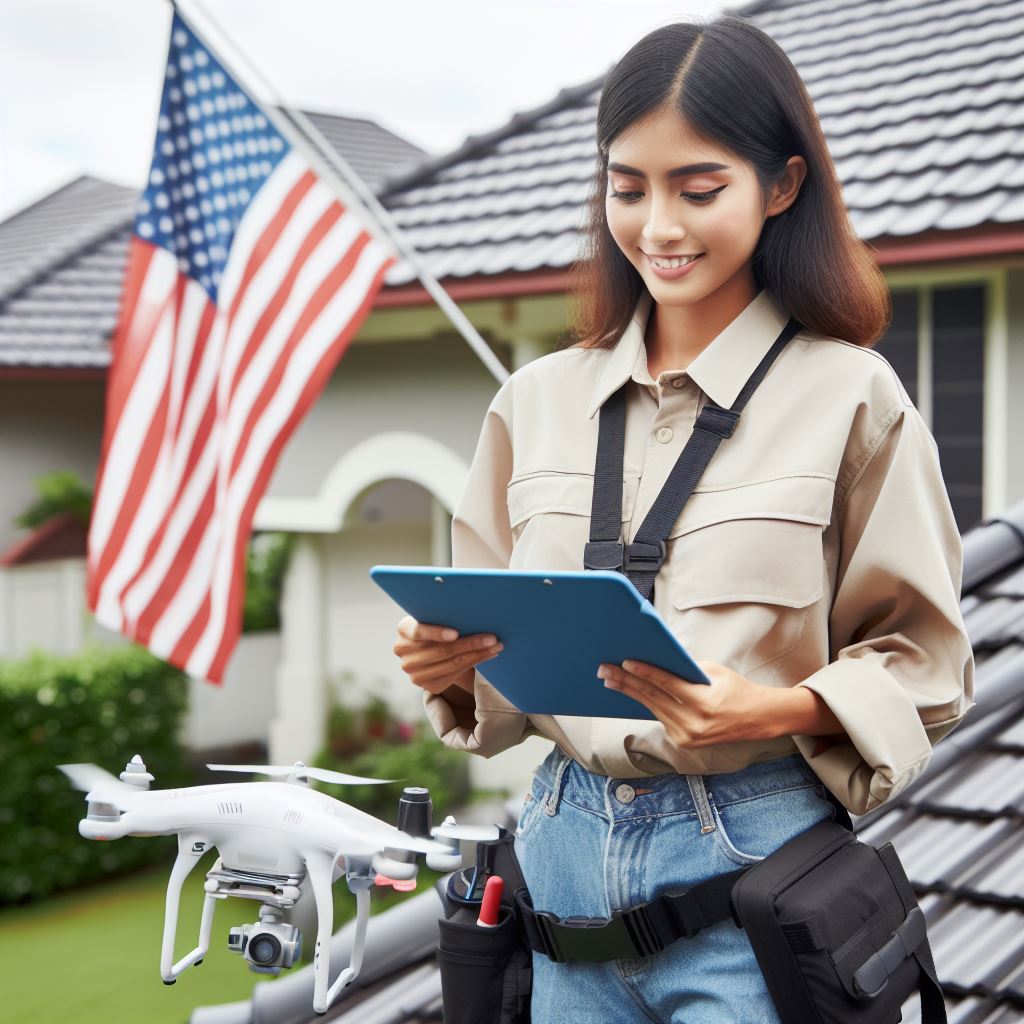Introduction
Property inspections play a crucial role in ensuring the safety and maintenance of buildings and properties.
Regular inspections help identify potential issues early on and prevent costly repairs or accidents.
Over the years, technology has revolutionized various industries, making tasks more efficient and accurate.
The field of property inspections is no exception, with the introduction of drones.
Introduction to drones for property inspections
Drones, also known as unmanned aerial vehicles (UAVs), have rapidly gained popularity in the field of property inspections.
These small aircraft equipped with high-resolution cameras can capture detailed imagery of buildings and properties from unique perspectives.
Drones eliminate the need for manual inspections, which can be time-consuming and sometimes risky for inspectors.
With the ability to fly over rooftops, buildings, and other inaccessible areas, drones provide a comprehensive view of the property.
Not only do drones save time, but they also offer cost-effective solutions for property inspections.
They can cover vast areas in a shorter span of time, reducing the manpower and resources required for traditional inspections.
Furthermore, drones can quickly detect potential issues such as roof damage, structural weaknesses, or even insulation problems.
Inspectors can analyze the images and videos captured by drones to make informed decisions and recommendations for repairs or maintenance.
In essence, the introduction of drones in property inspections has revolutionized the industry, making it more efficient, accurate, and cost-effective.
The importance of regular inspections combined with technological advancements underscores the value of integrating drones in property inspection processes.
Benefits of using drones for property inspections
Increased efficiency and speed
By leveraging the benefits of using drones for property inspections, real estate professionals can significantly enhance their operations and gain a competitive advantage.
Drones offer increased efficiency and speed in data collection and analysis.
Instead of manually inspecting each property, drones can swiftly navigate through different areas, capturing images and footage that provide crucial information for decision-making.
Enhanced safety for inspectors
Safety is another significant advantage of using drones for property inspections. Inspectors no longer need to physically enter risky or hazardous locations.
With drones, they can easily assess rooftops, tall structures, or even areas affected by natural disasters, minimizing the potential for accidents or injuries.
Cost-effectiveness
Moreover, employing drones for property inspections is cost-effective.
It eliminates the need for expensive equipment, such as scaffolding or harnesses, and reduces the manpower required for inspections.
This cost reduction makes drone-based inspections accessible to more real estate professionals, regardless of their budgets or resources.
Access to difficult-to-reach areas
The ability of drones to access difficult-to-reach areas is invaluable. In the past, inspecting rooftops or tall structures could be challenging and time-consuming.
However, drones can effortlessly navigate such locations, capturing detailed images and data that provide a comprehensive understanding of the property’s condition.
High-quality and accurate data collection
Furthermore, drones ensure high-quality and accurate data collection.
Equipped with advanced cameras and sensors, they can capture detailed images and collect precise data.
This enables inspectors to thoroughly evaluate the property, identifying potential issues that may have gone unnoticed during manual inspections.
Improved visual documentation
In addition to data collection, drones provide improved visual documentation.
High-resolution images and videos captured by drones offer a detailed record of the property’s condition, aiding in various decision-making processes.
This visual documentation can be utilized by real estate professionals, property owners, or buyers to assess the property’s value and make informed decisions.
Competitive edge for real estate professionals
Lastly, utilizing drones for property inspections gives real estate professionals a competitive edge in the market.
By showcasing their commitment to innovative and efficient practices, they stand out from their competitors.
Prospective clients and investors recognize the value of modern technologies in property inspections, increasing the chances of securing lucrative deals.
In fact, the benefits of using drones for property inspections are undeniable.
They enhance efficiency and speed, ensure inspector safety, reduce costs, provide access to difficult-to-reach areas, enable high-quality data collection, improve visual documentation, and give real estate professionals a competitive advantage.
Embracing this technology is a significant step towards revolutionizing the property inspection industry.
Read: Remote Property Management: Tech Tips
Types of drones used for property inspections
In the world of property inspections, drones have emerged as a valuable tool for capturing high-quality aerial imagery and conducting thorough surveys.
Drones offer numerous benefits, including cost-effectiveness, efficiency, and improved safety by eliminating the need for manual inspections in hazardous or hard-to-reach areas.
When it comes to property inspections, there are two main types of drones commonly used: multirotor drones and fixed-wing drones.
Multirotor drones
Multirotor drones are the most commonly used drones for property inspections due to their versatility and ease of use.
These drones are equipped with multiple rotors, usually four, which allow them to take off and land vertically.
One of the key advantages of multirotor drones is their stability and maneuverability.
They can hover in place and easily change direction, making them ideal for capturing detailed imagery and videos.
These drones also offer various features such as GPS navigation, obstacle avoidance, and high-resolution cameras.
Multirotor drones are particularly suitable for inspecting smaller properties, such as residential houses, apartments, or commercial buildings.
Their compact size allows them to navigate tight spaces and capture close-up shots of roofs, gutters, chimneys, and other structures.
These drones can also be equipped with thermal cameras for identifying heat leaks or electrical issues.
Fixed-wing drones
Fixed-wing drones, on the other hand, have a design and flight capabilities similar to aircraft.
These drones have a fixed wing and rely on forward motion for lift, allowing them to cover larger distances and stay airborne for extended periods.
One of the key advantages of fixed-wing drones is their ability to cover extensive areas quickly.
They can fly in a straight line and cover large swaths of land, making them ideal for inspecting larger properties such as farms, estates, or rural areas.
Fixed-wing drones also offer longer flight times compared to multirotor drones, which increases their efficiency in conducting inspections.
Although fixed-wing drones require more space for takeoff and landing, they are well-suited for open areas without obstacles or restricted airspace.
They are commonly used for mapping, surveying, and conducting aerial inspections in expansive properties.
In short, both multirotor and fixed-wing drones have their advantages and are suitable for different types of property inspections.
Multirotor drones excel in maneuverability and capturing detailed imagery in smaller properties, while fixed-wing drones shine in covering larger areas efficiently.
Depending on the specific requirements of the property inspection, professionals can choose the type of drone that best fits their needs.
Essential features and specifications to look for in a property inspection drone
A property inspection drone is a valuable tool for assessing the condition of a property, providing a comprehensive view from all angles.
When choosing a drone for property inspections, there are several essential features and specifications to consider.
Flight time and range
The drone’s flight time and range are crucial factors to consider.
Look for drones with longer flight times and extended ranges to cover larger properties effectively.
Camera quality and resolution
The camera quality and resolution are essential for capturing clear and detailed images and videos.
Drones with high-quality cameras ensure accurate property inspections.
Controlled navigation and stability
Smooth and controlled navigation is vital for conducting property inspections.
Drones with stable flight capabilities and obstacle avoidance technology are preferable for accurate inspections.
GPS and mapping capabilities
GPS and mapping capabilities are beneficial for property inspections.
Drones with GPS integration can provide precise location information and create detailed maps of the property.
Payload capacity
The payload capacity of a drone determines its ability to carry extra equipment, such as thermal sensors or specialized cameras.
Consider the weight and size limitations for the intended inspection requirements.
Flight planning software compatibility
Flight planning software compatibility is essential for efficient and systematic property inspections.
Look for drones that are compatible with popular software programs to simplify flight route planning.
Weather resistance
Property inspections can often take place in various weather conditions.
Choosing a drone with weather-resistant features ensures that it can withstand rain, wind, and other challenging environments.
When investing in a property inspection drone, prioritize these essential features and specifications based on your specific needs.
Assess your requirements and budget to select a drone that can effectively carry out property inspections with precision and accuracy.
Read: Local vs National: Real Estate Market Insights
Legal considerations for using drones in property inspections
Federal Aviation Administration (FAA) regulations
- Licensing and registration requirements: In order to operate a drone for property inspections, it is mandatory to obtain a license from the FAA. Additionally, the drone needs to be registered with the FAA.
- Operating restrictions: The FAA has set certain operating restrictions for drones used in property inspections. These include a maximum height limit of 400 feet above ground level and a speed limit of 100 miles per hour.
Local regulations and permits
In addition to federal regulations, it is important to be aware of and comply with any local regulations and permit requirements for operating drones in property inspections.
These regulations can vary from one jurisdiction to another.
Privacy concerns and best practices
When using drones for property inspections, there are privacy concerns that need to be addressed.
It is essential to respect the privacy of property owners and ensure that the drone is not used to invade their privacy.
Best practices for privacy in drone property inspections include:
- Obtaining consent from property owners before conducting inspections
- Avoiding capturing images or videos of areas not relevant to the inspection
- Storing data securely and deleting it once the inspection is completed
- Using drones equipped with privacy features, such as blurring or obscuring faces and license plates in captured images
It is crucial to stay updated with any changes or updates in regulations related to drones and property inspections, as the laws are continuously evolving.
Read: Property Investment: Spotting the Trends

Steps to conduct a successful property inspection using drones
Drones have revolutionized property inspections, making the process more efficient and cost-effective than ever before.
By utilizing aerial technologies, property inspections can be conducted with greater ease, accuracy, and speed.
Here is a step-by-step guide on how to conduct a successful property inspection using drones.
Pre-flight preparations
Before embarking on any property inspection, it is crucial to check the drone and equipment condition.
Ensure that the drone is in good working order and that all necessary equipment, such as batteries and cameras, are functioning properly.
Additionally, it is essential to secure the necessary permissions and permits to conduct the property inspection.
Depending on your location and the regulations in place, you may need to obtain permission from local authorities or property owners.
Flight planning and safety precautions
Once all pre-flight preparations are complete, the next step is to identify the areas of the property that need to be inspected.
Create a detailed flight plan that outlines the specific locations and routes that the drone will take during the inspection.
Before deploying the drone, it is important to assess the weather conditions.
Drones are sensitive to strong winds, rain, and extreme temperatures, which can affect their flight capabilities.
Ensure that the weather conditions are suitable for safe and effective drone operations.
Data collection and analysis
During the property inspection, the drone should be used to capture high-resolution images and videos of the property.
These visual assets provide valuable data for analysis and evaluation. It is important to ensure that the drone captures clear and accurate imagery.
Once the data is collected, specialized software can be utilized for data analysis.
This software can process the images and videos, extracting valuable insights and information about the condition of the property.
The software may also offer features such as 3D modeling, thermal imaging, and measurement tools.
In general, conducting property inspections using drones offers numerous advantages.
By following these steps, the process can be streamlined and optimized for maximum efficiency and effectiveness.
Drones have revolutionized the property inspection industry, allowing for safer, more accurate, and cost-effective assessments.
Read: Rental ROI: Maximizing Your Investment
Find Out More: Top Property Management Tips to Maximize Your Rental Income
Case studies and examples of successful drone-assisted property inspections
Residential properties
In a suburban neighborhood, a homeowner used a drone to inspect the roof of their two-story house.
The drone captured high-resolution images, allowing them to detect damaged shingles that were not visible from the ground.
A real estate agent utilized drones to capture aerial footage of a luxury property with a large backyard and swimming pool.
By showcasing the property from a unique perspective, the agent attracted more potential buyers and eventually closed a significant sale.
Following a severe storm, an insurance company deployed drones to assess the damage to various residential properties.
The aerial view provided by the drones helped the adjusters quickly identify affected areas and estimate repair costs accurately.
Commercial properties
A construction company used drones to conduct an inspection of a high-rise building under construction.
The drones captured detailed images of the façade, enabling the project manager to spot potential structural issues and ensure compliance with safety regulations.
In a shopping mall, security personnel employed drones to monitor the premises during peak hours.
The unmanned aerial vehicles provided an additional layer of surveillance, enhancing the overall security framework and reducing the risk of criminal activities.
When a large office building required an assessment of its rooftop HVAC system, a maintenance team relied on drones to inspect the complex equipment.
The aerial view helped them identify malfunctioning components and plan for necessary repairs efficiently.
Industrial properties
A power plant utilized drones for the inspection of its tall chimneys.
The drones captured real-time footage, allowing engineers to detect potential cracks or damages, which could lead to hazardous emissions if left unattended.
In an oil refinery, drones were deployed to inspect pipelines and identify potential leaks.
The aerial perspective improved detection accuracy, enabling prompt repairs and preventing environmental hazards.
A mining company employed drones to survey their vast open-pit mines.
The drones provided high-resolution imagery, facilitating the identification of potential risks and aiding in proper planning and resource allocation for safe mining operations.
These case studies and examples illustrate the diverse applications of drone-assisted property inspections across various property types.
With their ability to capture high-resolution images, provide unique perspectives, and improve efficiency, drones are revolutionizing the inspection process in the real estate, construction, insurance, and industrial sectors.
As technology continues to advance, the use of drones in property inspections is expected to become even more prevalent, enhancing safety, accuracy, and cost-effectiveness.
Future advancements and potential impact of drones in property inspections
Integration of artificial intelligence and machine learning
The use of drones in property inspections will be enhanced through the integration of artificial intelligence and machine learning.
AI algorithms can analyze data collected by drones to identify potential issues in properties.
This integration will enable drones to autonomously detect and report on various structural and maintenance problems.
Machine learning algorithms will continuously improve the accuracy and efficiency of property inspections carried out by drones.
With AI capabilities, drones can quickly assess properties, providing valuable insights to property owners and inspectors.
Automation of inspection processes
- Advancements in drone technology will further automate the property inspection process.
- Automation will allow drones to fly pre-programmed routes and conduct inspections without constant human intervention.
- This will significantly reduce the time and effort required to inspect large and complex properties.
- Drones equipped with advanced sensors and cameras can capture detailed images and videos for thorough inspection analysis.
- Automated inspections will ensure consistent and precise data collection, improving the accuracy of property assessments.
Increased adoption in the real estate industry
- The real estate industry is increasingly recognizing the benefits of using drones for property inspections.
- Drones can provide a cost-effective and time-efficient alternative to traditional manual inspections.
- As more property owners and inspectors experience the advantages of drones, their adoption will continue to rise.
- Drones offer a safer way to inspect properties, eliminating the need for individuals to access potentially hazardous areas.
- The integration of drones in property inspections has the potential to revolutionize the real estate industry.
In a nutshell, future advancements in drone technology will pave the way for greater integration of artificial intelligence and machine learning in property inspections.
This will enable drones to autonomously identify and report on property issues, improving the accuracy and efficiency of inspections.
Automation will further streamline the inspection process, reducing time and effort while ensuring consistent and precise data collection.
The real estate industry is increasingly embracing drones as a cost-effective and time-efficient solution for property inspections, leading to their increased adoption.
Overall, drones have the potential to revolutionize property inspections and transform the way the real estate industry operates.
Conclusion
Using drones in property inspections offers numerous benefits and advantages.
Firstly, it allows for a more comprehensive and detailed assessment of the property, capturing high-resolution images and videos from various angles.
Secondly, drones provide a safer alternative to manual inspections, eliminating the need for personnel to physically access hazardous or hard-to-reach areas.
This reduces the risk of accidents or injuries.
In addition, drones are cost-effective. They require minimal equipment and can be operated by a single person, significantly cutting down on inspection expenses.
Furthermore, drones can save time. With their ability to cover large areas in a short span, inspections can be completed more quickly, allowing for faster decision-making and action planning.
Moreover, drones provide real-time data and immediate feedback.
The collected data can be transmitted and analyzed on-site, enabling inspectors to detect and address issues promptly.
Encouraging the use of drones in property inspections is crucial.
The technology is constantly evolving, bringing further advancements in terms of accuracy, autonomy, and functionality.
By embracing drones, property owners, insurance companies, and inspection agencies can benefit from improved efficiency, enhanced safety, and reduced costs.
Transitioning to drone-based property inspections requires investment in equipment, training, and regulatory compliance.
However, the long-term advantages and potential return on investment make it a worthwhile endeavor.
Drones have revolutionized the field of property inspections, providing a more efficient, safe, and cost-effective solution.
Embracing this technology will undoubtedly lead to better property management and more informed decision-making.
Therefore, it is essential for industry professionals to explore and adopt drones in property inspections to stay ahead of the curve.
By doing so, they can unlock the full potential of this innovative tool and ensure the success and sustainability of their property-related endeavors.




